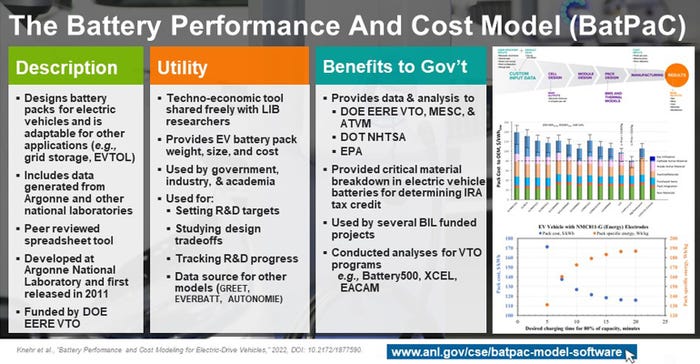Techno-Economics and Battery Business Reality
How the dry science of techno-economics can sweeten battery business success, as explained at Argonne National Laboratory.
March 23, 2023

“Morality, it could be argued, represents the way that people would like the world to work. Economics represents how it actually does work.” This sage pronouncement from Freakonomics is followed a bit later by the equally sage advice: “Knowing what to measure and how to measure it makes a complicated world much less so.”
There are few industries where these impact harder than in the battery business. Design development and analysis is never-ending; plant construction costs are measured in billions of dollars; battery applications range from planes, trains, and automobiles to watches, tablets, and pacemakers; chemistry compositions are constantly evolving; and supply chains and production systems are far from simple and straightforward.
Even government incentives and access to capital in the hundreds of millions does not assure success. Earlier this year, Battery Technology covered the bankruptcy of the UK’s Britishvolt proposed gigafactory (“Britishvolt Bankruptcy: What Went Wrong?”). Myriad mistakes and missteps all boil down to a simple truth: Making batteries at scale is not easy. Neither is it cheap.
There is help
Fortunately, there is a tool that brings economic analysis to bear on the numerous techno aspects of battery design and production. BatPaC (Battery Performance and Cost) is an Excel spreadsheet in Microsoft Office available from Argonne National Laboratory specifically for estimating performance and manufacturing costs of lithium-ion batteries for electric-drive vehicles, including hybrid-electrics (HEV), plug-in hybrids (PHEV) and pure EVs. First developed in 2007, the effort is being funded by the Vehicle Technology Office (VTO), part of the Energy Efficiency and Renewable Energy (EERE) office of the US Department of Energy (USDOE). The model was publicly and privately peer-reviewed by experts in the field and was selected as the cost model of choice by the U.S. Environmental Protection Agency (EPA). The EPA is using BatPaC in its rule-making process for reducing greenhouse gas emissions and improving fuel economy in light-duty vehicles. Moreover, BatPaC has and continues to be available free of charge upon request from Argonne since 2012.

In Argonne’s words, BatPaC serves the greater battery community in studying the impact of material properties on battery performance at the pack level. “Indeed, cost may not be the primary goal in using BatPaC,” says Argonne senior chemical engineer and longtime BatPaC developer Shabbir Ahmed, PhD.
Primary considerations could include designing a battery for a specific application with such inputs as the power required, for what range, and how fast to recharge. The model employs a bottom-up calculation, where the size, mass, and cost of a battery pack is determined from inputs related to the battery chemistry, vehicle type, pack configuration and manufacturing specifications. With the battery cell being the fundamental building block of the battery pack, using BatPaC allows studying how changes in the cell impact the total pack design. This is particularly useful when comparing cells with different material properties, prices, cell specifications, and production processes.
Manufacturing steps and cost factors
Manufacturing is not overlooked in BatPaC. Indeed, the model takes multiple production steps specific to battery manufacturing into cost consideration. These include electrode slitting, cell stacking, current collector welding, x-ray inspection, pack and module assembly, and others. The cost factors of installed capital equipment, labor, and manufacturing floor space (loaded with overhead costs such as building support systems for each step in the manufacturing process) are based on those in a baseline plant with a capacity of 50 GWh per year.

Some of the input parameters in the spreadsheet use values and equations derived from external sources such as experiments or correlations from experimental/published data, transport or process models, and industry feedback on costs and manufacturing procedures.
Such calculations can be adapted for grid storage and other battery applications as well.
Far from remaining static, Argonne continues to add more data and functionalities to BatPaC, including new materials, fast charge constraints, trends in pack design, effect of plant utilization, and more, Ahmed says. Industry recognition has included BatPaC v5.0 being named to the 2022 “R&D 100”, colloquially referred to as the “Oscars of innovation.”
Perhaps the most invaluable results from applying BatPaC and techno-economic modeling to battery design and production is estimating what a battery design and its production at scale might cost and the cost savings that might be achieved with improvements in any material or process.
For further inquiries, Dr. Ahmed can be contacted at [email protected].
Editor’s Note: This is Part 7 in our series on the Brave New World of Battery Manufacturing. Read Part 1 on the Federal Consortium for Advanced Batteries Roadmap and investment issues; Part 2 on Current Research; Part 3 on Boom-Time Battery Production; Part 4 on Battery Materials’ Scarcities and High Prices, Part 5 on Why Recycling is Essential to the Battery Business, and Part 6 on Battery Workforce Development. And watch for our final installment, coming soon.
About the Author(s)
You May Also Like





